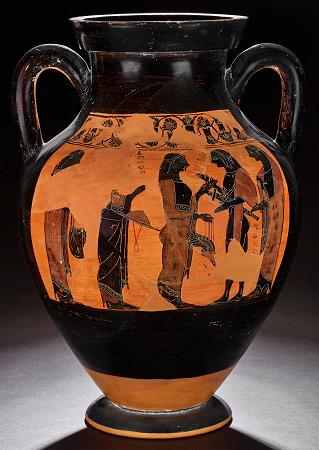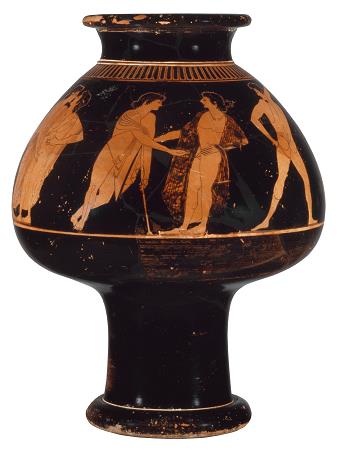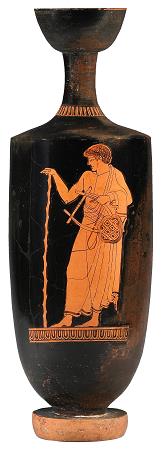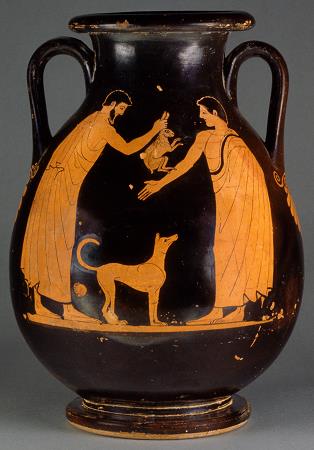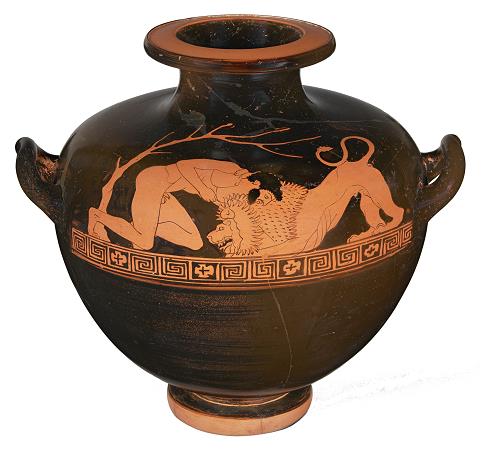Getty Museum. Paul Getty Museum, commonly referred to as the Getty, is an art museum in California housed on two campuses: the Getty Center and Getty Villa. The two locations received over two million visitors in 2016. The primary museum, located at the Getty Center, is in the Brentwood neighborhood of Los Angeles, on a hilltop above the west side of the Sepulveda Pass and I-405 freeway. The Museum houses primarily-European paintings, drawings, sculpture, illuminated manuscripts, and decorative arts; and photography from its beginnings to the present, gathered internationally. The secondary museum, the Getty Villa, is in the Malibu neighborhood and displays art from Ancient Greece, Rome, and Etruria. In 1974, J. Paul Getty opened a museum in a re-creation of the Villa of the Papyri at Herculaneum on his property in Malibu, California. In 1982, the museum became the richest in the world when it inherited US $1.2 billion. In 1983, after an economic downturn in what was then West Germany, the Getty Museum acquired 144 illuminated medieval manuscripts from the financially struggling Ludwig Collection in Aachen; John Russell, writing in The New York Times, said of the collection, One of the finest holdings of its kind ever assembled, it is quite certainly the most important that was in private hands. In 1997, the museum moved to its current location in the Brentwood neighborhood of Los Angeles; the Malibu museum, renamed the Getty Villa, was renovated and reopened in 2006. A suite of interactive multimedia tools called GettyGuide allows visitors to access information about exhibitions. Within the Museum, the GettyGuide multimedia player provides commentary from curators and conservators on many works of art. In the 1970s and 1980s, the curator, Frel, designed a tax manipulation scheme which expanded the museum collection of antiquities, essentially buying artifacts of dubious provenance, as well as a number of artifacts generally considered fakes, such as the Getty kouros. In 1984, Frel was demoted, and in 1986, he resigned. The Getty is involved in a controversy regarding proper title to some of the artwork in its collection. The museum's previous curator of antiquities, Marion True, was indicted in Italy in 2005 on criminal charges relating to trafficking in stolen antiquities. Similar charges have been addressed by the Greek authorities. The primary evidence in the case came from the 1995 raid of a Geneva, Switzerland, warehouse which had contained a fortune in stolen artifacts. Italian art dealer Giacomo Medici was arrested in 1997; his operation was thought to be one of the largest and most sophisticated antiquities networks in the world, responsible for illegally digging up and spiriting away thousands of top-drawer pieces and passing them on to the most elite end of the international art market. In 2005 True was forced to tender her resignation by the Board of Trustees, which announced her early retirement. Italy allowed the statute of limitations of the charges filed against her to expire in October 2010. In a letter to the J. Paul Getty Trust on December 18, 2006, True stated that she was being made to carry the burden for practices which were known, approved, and condoned by the Getty's Board of Directors. True is currently under investigation by Greek authorities over the acquisition of a 2,500-year-old funerary wreath. The wreath, along with a 6th-century BC statue of a woman, have been returned to Greece and are exhibited at the Archaeological Museum of Thessaloniki. On November 20, 2006, the director of the museum, Michael Brand, announced that 26 disputed pieces were to be returned to Italy, but not the Victorious Youth, which is still claimed by the Italian authorities. In 2007, the Los Angeles J. Paul Getty Museum was forced to return 40 artifacts, including a 5th-century BC statue of the goddess Aphrodite, which was looted from Morgantina, an ancient Greek settlement in Sicily. The Getty Museum resisted the requests of the Italian government for nearly two decades, only to admit later that there might be 'problems' attached to the acquisition. In 2006, Italian senior cultural official Giuseppe Proietti said: The negotiations haven't made a single step forward. Only after he suggested the Italian government to take cultural sanctions against the Getty, suspending all cultural cooperation, did the J. Paul Getty Museum return the antiquities. In another unrelated case in 1999, the Getty Museum had to hand over three antiquities to Italy after determining they were stolen.
more...

